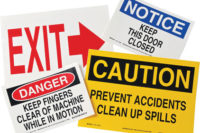The creation of safety signage typically involves the following three steps:
1. A hazard analysis determines what hazards need to be included in the signage.
2. Technical writers focus on making sure the language correctly describes the hazard and explains what the employee should do to avoid it. The writers may also determine that the sign’s vocabulary is understandable at a certain educational level, such as 8th grade.
3. Designers focus on making the sign salient and aesthetically pleasing by using pictorials, color and other graphical elements.
So why is this process often not sufficient to elicit compliance? The answer involves the context in which workers interact with the signage.
Brief intro to signage
In order for signage to be effective, it needs to achieve four goals that, while similar, actually take different complementary approaches. For a sign to be effective a worker must:
1. Notice: If workers do not even notice a sign, it cannot be effective. Effectiveness requires more than big, bright letters and graphics. While safety training is usually enough to enable workers to understand what they should do, when things get busy and workers feel tired, rushed or forced to focus on other aspects of the job, safe practices can easily be overlooked. At times like this, the sign needs to intrude to present a visual reminder.
2. Read: Even when workers notice a sign, they may not read it. Why not? Because they “know” what it is going to say — so why waste the time? Or they don’t perceive any danger in their environment — so again, why waste the time? The problem is that the information on the sign may not be what every worker is focusing on at that particular moment.
3. Understand: Workers come from a wide variety of backgrounds, and it is hard to predict what they will understand, no matter how carefully they read a sign. Some workers don’t have a traditional education and may have limited vocabulary. Some have limited experience and don’t understand the industry jargon. Some are recent immigrants and don’t speak much English. In each case they may not understand even a simply worded sign. Similarly, graphics are often confusing or convey an incomplete description of the hazard.
4. Comply: Compliance is the ultimate goal of signage. While the first three goals are important, they have been the subject of many other articles. For this reason the rest of this article will focus on compliance.
Obstacles to compliance
When a worker has noticed, read and understood a safety sign, why might he or she not comply? There are several possible reasons. Here are a few:
• Perceived likelihood: Most hazards don’t often cause significant injuries. So why should a worker risk missing production incentives, appear wimpy in front of coworkers, or otherwise deviate from the path of least resistance in order to protect himself against a hazard that is rarely going to result in an injury? In addition, workers often have a superman complex — even if it happens to other people, it will never happen to me.
• Perceived severity: Even when a hazard does lead to an injury, it is often relatively minor. So again, why risk production incentives or reputation to be careful?
• Cost of compliance: Compliance is also affected by the amount of time and effort required to comply with safe practices. The more time and effort a safe practice requires, the more tempting it is for workers to skip it. In one study, workers were more likely to use gloves and goggles when handling hazardous chemicals when the PPE was located in a drawer next to the chemicals than when it was across the room. In another study, workers were more likely to use a glide when sawing wood when the glide was attached to the front of the table than when it was attached to the side. Face it — in the end we are all lazy.
What are the consequences?
A hazard that can result in a very serious injury is more likely to elicit compliance than a hazard that can only lead to a minor one. But there is much more to the evaluation of consequences. Is the company lax about incidents of noncompliance? Does the worker have strong union protection? Is the company located in a state with generous workers’ comp benefits? These are not necessarily foremost in one’s mind during a specific incident, but over time these factors can lead to more or less risk-taking behavior in general.
Every company handles injuries and product damage differently. In some cases there is little investigation and workers can sweep their compliance failures under the rug. In others there is a high likelihood of getting caught. Have you ever seen a worker look both ways before violating a safe practice? Is anyone looking? Is the safety manager in the room?
Workplace safety culture
In several of the above cases, workplace culture is involved. In what direction is the peer pressure pushing? Culture can motivate workers to comply if it has a strong safety component. On the other hand, a macho culture can motivate workers who may actually care about behaving safely to take the same shortcuts others are taking.
Effective sign design
By now the message should be clear. Because it is necessary to understand when and if any of these obstacles may be present, safety signage designers need to roll up their sleeves and get into the workplace where they can talk to workers and see for themselves the context in which the sign will be placed. Only then can technical writing and aesthetic design skills be brought to bear to create an effective warning.

